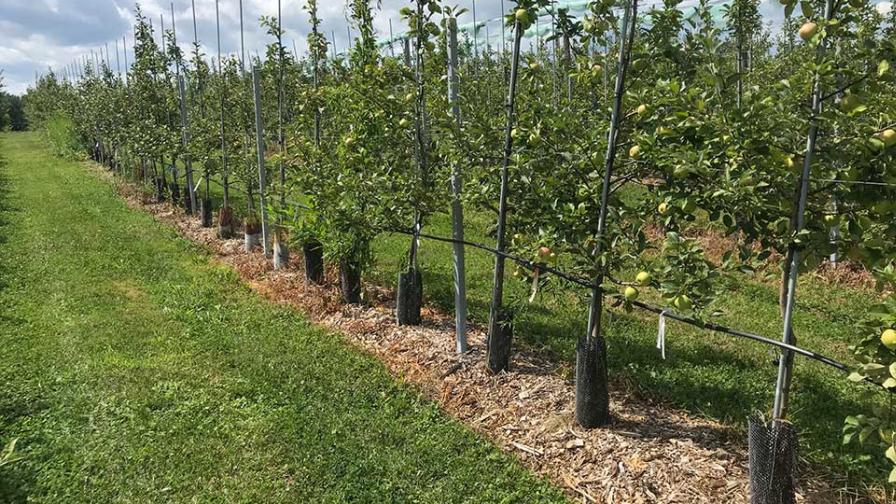Organic Weed Control Strategies for Apple Growers

Got weeds in your organic apple orchard? Pictured is an example of mulch (main treatment) plus organic herbicide (split treatment).
Photo courtesy of Cornell University
Weed control remains the most significant issue among organic apple growers in the Northeastern U.S., according to Cornell University’s Greg Peck. For them, “it’s among the hardest things to control,” the Assistant Professor of Horticulture, Sustainable Fruit Production Systems, says.
At the fore of their dilemma is the lack of effective organic weed control options. None works particularly well alone, Peck says, but many work well in combination, particularly wood-chip mulch and organic herbicides.
“What we’ve found is that single options on their own do not seem to effectively control weeds year after year,” he says. “So, how do we combine them to see if we can improve the efficacy?”
Peck and one of his graduate students, Kate Brown, spent four years (2016-2019) on an experiment designed to determine the ideal integrated approaches in an organic, high-density apple orchard during establishment years. They studied ‘Honeycrisp Firestorm’ trees on Bud.9 rootstock that had been planted in 2015 at Cornell Orchards in Ithaca, NY. The trees were then trained to a tall spindle orchard system (1 meter by 4 meters).
“That is a fairly weak-growing cultivar and weak-growing rootstock, which was intentional. I really wanted to see what happened when we had some weed pressure on the trees,” Peck says. “If I was a commercial organic apple grower, I’d be very hesitant to plant that combination, just because of the lack of vigor.”
The trial’s split-plot design consisted of three main plots and four randomized blocks for a total of 12 unique treatments.
The three main plots were: 1) untreated control; 2) cultivation (Wonder Weeder), and 3) wood chip mulch (a mix of hard and soft woods applied once in 2016 at a depth of 6 inches and width of 18 inches on each side of the tree). The four split plots were: 1) untreated control; 2) Final-San-O (17% solution of ammoniated soap of fatty acids; Certis USA); 3) Suppress (6% solution of caprylic acid/capric acid; Westbridge Agricultural Products), and 4) mowing (string trimmer).
Four applications occurred each year, with the weeds being sampled beforehand in each case. Also examined were soil cores, leaf tissue, fruit harvest, and trunk cross-sectional area.
STUDY RESULTS
The mulch treatment had lower percent cover than the cultivation treatment all three years and lower percent cover than the untreated main plot in 2017 and 2018.
Both herbicide treatments resulted in significantly lower percent weed cover than the mowing and untreated control split treatments, including 37% lower in 2018 and 31% lower in 2019.
“The herbicide is better than mowing. In fact, mowing and the untreated control were about the same,” Peck says. “Mowing is visual. You knock the weeds back, but we didn’t find any benefit in terms of weed control or tree growth.”
Dicots, particularly the perennial rhizomatous species, were most problematic in the trial, particularly late in the season, Peck says. Creeping buttercup was especially troublesome. Without using a split treatment, particularly one involving an herbicide, none of the main treatments successfully controlled dicots. Meanwhile, the herbicides controlled monocots better than mowing, and mulch did best at controlling monocots.
BEYOND WEEDS
The mulch treatment alone improved soil quality — organic matter, active carbon, soil protein, aggregate stability, and soil respiration — and limited weed pressure for three years after application.
With regard to horticultural parameters, cultivation plus herbicide resulted in the largest trees, while mulch and control were very similar. Mowing was no different than doing no weed control.
“Again, the stacked (herbicide) treatments worked to a benefit and did better than the mulch without a second treatment on top of it,” Peck says.
In other statistical analyses, leaf nitrogen was the variable most associated with tree growth, followed by soil nitrogen.
“One of the things we see in organic production is a decrease in the nitrogen status in the trees,” Peck says. “And that’s something that growers are really going to have to be aware of while perhaps looking at some foliar nitrogen applications to increase plant nitrogen content.”
Meanwhile, increased weed biomass was negatively correlated with tree growth and leaf nitrogen. While soil quality metrics are positively correlated to each other, they are negatively correlated to tree growth.
“Which is interesting because a lot of people say that, with an increase in soil quality, you’re going to have healthier trees. But that’s not always the case. So, with the mulch we’re able to increase soil quality quite a bit, but it did not necessarily result in better tree growth. We think that has to do with the soil volumetric water content. The mulch was most likely holding on to too much water in the wet year in 2018.”
In conclusion, Peck says cultivation and mulch, when used alone, are not sufficient to control weeds, but when stacked with an herbicide, they perform adequately. He suggests using mulch plus herbicide in the early establishment years (1-4) and switching to cultivation in later years.
Other tips include focusing on early-season organic weed control (May to early July), using hand labor (hoeing) if perennial weeds become established, starting with more competitive rootstocks (not Bud.9), taking leaf samples while applying foliar nitrogen, as needed, and considering slow-growing cover crops.










